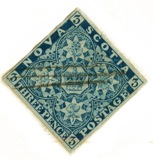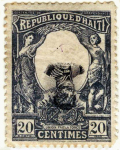
Discussion - Member to Member Sales - Research Center

Discussion - Member to Member Sales - Research Center

 As with my last couple of postings here, I’m splitting an article between the philatelic aspects, here, and the more historical elements at http://juicyheads.com/link.php?PLLTJIJE. Both parts have fairly interesting stories to tell.
As with my last couple of postings here, I’m splitting an article between the philatelic aspects, here, and the more historical elements at http://juicyheads.com/link.php?PLLTJIJE. Both parts have fairly interesting stories to tell. From a philatelic point of view, this is a tourist who forgets, or chooses not, to affix postage to a post card. Perhaps he knows that with no return address, he’s not going to get dunned by the Police Postale for few centimes owed. Can’t imagine the Tarbells are too happy to hear from Henry, especially if this is a normal economy measure.
One can see from the “T†in the triangle that the French postal authorities did, indeed, note its franking deficiency. “T†is the initial letter of “taxe,†meaning toll, or what’s owed. It’s unclear to me which of the first Parisian cancels is associated with the T; perhaps both are. I don’t know whether the other cancel pre- or post-dates the due marking. If latter, it’s probably meant as a release into the international mail stream, knowing that the collection of money owed would be across the Atlantic. And it is there, in New York, where it is assessed 6c postage due. I don’t believe the money is paid here, but rather it’s sent on to Michigan, where the Tarbells must pay 6c for one of the more banal tourist recountings.
The triangular T is not the only due marking. In New York, the 6c postage due is identified in the “opera glasses†hand stamp, with adjustable numeral. Jim Forte has some nice opera glass cancels listed in his offerings: http://www.postalhistory.com/results.asp?task=&y1=&y2=&searchtype=&dt=&cc=&dq=&po=&du=&ct=&cs=pd-us&ts=&st=&sort=3&Auction=&group=20&pagenum=6. I include this to show other examples, not to push these. Harmer has several, too, but they realized more princely sums: http://stampauctionnetwork.com/ha/ha300057.cfm. There are a variety of sizes and texts used in the various cities. I’m not sure whether the differences are common to the city or period or just happenstance. I’d be delighted with more information. I thought we had discussed these cancels before, but the only reference I could find was merely anecdotal, and not a due marking at all, but a receiving cancel from New York: http://stamporama.com/discboard/disc_main.php?action=20&id=5065#29326


Login to Like
this post
Yes, David, I too think that we had a discussion touching on these opera glass cancels, but also can't recall the context.
I do have a few in my collection and I am happy to share:
Your cancel goes with this style (known from about 1920 into the 60s). I have the 2 cents and 5 cents; you supplied the 6 cents due (there also is an 8, 10, and 20 cents due of this style):

Then, there is an earlier syle, of which I have a couple of examples:

What do all of these have in common (including David's example)? -- All are neatly located in the bottom left corner. Why is that? Because they are not hand cancels, but machine cancels.
There do also exist opera glas postage due hand cancels; many examples of which are included in the links David provided. The machine impressions appearing from 1902 to maybe the late 50s (two 20mm circles separated by a 3.0 mm space) were obviously modelled after the earlier hand cancel style, which tend to display narrower spacing. But the location of the marking usually is a much easier and more obvious indicator in the vast majority of cases than measurements.
I do not collect the hand cancel varieties, so I can't show any, but there are plenty examples accessible via the links David provided. Value, in my judgement, is pretty low for any of these appearing on postcards. I would not be spending more than a dollar or two. Postage due stamps, if present, of course add interest. Rarely, however, is the value in the opera glass marking - nobody that I know collects these.
I have never seen an opera glass style postage due marking from any city other than New York. How incoming international unpaid/underpaid mail was to be handled was subject to the UPU treaties. New York was the central post office to handle this mail. Clerks had to know all postage rates internationaly in order to determine the amount of underpayment and then translate the foreign currency deficiency into the UPU french gold franc currency and then into US dollars. So it made sense to centralize this knowhow in one place and mark the mail accordingly, so that the local P.O only had to collect, but did not have to figure out the amount due.
This is quite an interesting chapter. Today of course underpaid international mail will not be delivered.

Login to Like
this post
this is so interesting, Arno. I had no idea that the markings were machine-applied. Thanks. Hudson Terminal, was rented from a space in the Hudson and Manhattan RR terminal, beginning in 1905. This space is where the Trade Towers were later erected.
David

Login to Like
this post
Auctions
 As with my last couple of postings here, I’m splitting an article between the philatelic aspects, here, and the more historical elements at http://juicyheads.com/link.php?PLLTJIJE. Both parts have fairly interesting stories to tell.
As with my last couple of postings here, I’m splitting an article between the philatelic aspects, here, and the more historical elements at http://juicyheads.com/link.php?PLLTJIJE. Both parts have fairly interesting stories to tell.
From a philatelic point of view, this is a tourist who forgets, or chooses not, to affix postage to a post card. Perhaps he knows that with no return address, he’s not going to get dunned by the Police Postale for few centimes owed. Can’t imagine the Tarbells are too happy to hear from Henry, especially if this is a normal economy measure.
One can see from the “T†in the triangle that the French postal authorities did, indeed, note its franking deficiency. “T†is the initial letter of “taxe,†meaning toll, or what’s owed. It’s unclear to me which of the first Parisian cancels is associated with the T; perhaps both are. I don’t know whether the other cancel pre- or post-dates the due marking. If latter, it’s probably meant as a release into the international mail stream, knowing that the collection of money owed would be across the Atlantic. And it is there, in New York, where it is assessed 6c postage due. I don’t believe the money is paid here, but rather it’s sent on to Michigan, where the Tarbells must pay 6c for one of the more banal tourist recountings.
The triangular T is not the only due marking. In New York, the 6c postage due is identified in the “opera glasses†hand stamp, with adjustable numeral. Jim Forte has some nice opera glass cancels listed in his offerings: http://www.postalhistory.com/results.asp?task=&y1=&y2=&searchtype=&dt=&cc=&dq=&po=&du=&ct=&cs=pd-us&ts=&st=&sort=3&Auction=&group=20&pagenum=6. I include this to show other examples, not to push these. Harmer has several, too, but they realized more princely sums: http://stampauctionnetwork.com/ha/ha300057.cfm. There are a variety of sizes and texts used in the various cities. I’m not sure whether the differences are common to the city or period or just happenstance. I’d be delighted with more information. I thought we had discussed these cancels before, but the only reference I could find was merely anecdotal, and not a due marking at all, but a receiving cancel from New York: http://stamporama.com/discboard/disc_main.php?action=20&id=5065#29326


Login to Like
this post

re: Postage Due Markings on Picture Post Card from Paris, summer \'30
Yes, David, I too think that we had a discussion touching on these opera glass cancels, but also can't recall the context.
I do have a few in my collection and I am happy to share:
Your cancel goes with this style (known from about 1920 into the 60s). I have the 2 cents and 5 cents; you supplied the 6 cents due (there also is an 8, 10, and 20 cents due of this style):

Then, there is an earlier syle, of which I have a couple of examples:

What do all of these have in common (including David's example)? -- All are neatly located in the bottom left corner. Why is that? Because they are not hand cancels, but machine cancels.
There do also exist opera glas postage due hand cancels; many examples of which are included in the links David provided. The machine impressions appearing from 1902 to maybe the late 50s (two 20mm circles separated by a 3.0 mm space) were obviously modelled after the earlier hand cancel style, which tend to display narrower spacing. But the location of the marking usually is a much easier and more obvious indicator in the vast majority of cases than measurements.
I do not collect the hand cancel varieties, so I can't show any, but there are plenty examples accessible via the links David provided. Value, in my judgement, is pretty low for any of these appearing on postcards. I would not be spending more than a dollar or two. Postage due stamps, if present, of course add interest. Rarely, however, is the value in the opera glass marking - nobody that I know collects these.
I have never seen an opera glass style postage due marking from any city other than New York. How incoming international unpaid/underpaid mail was to be handled was subject to the UPU treaties. New York was the central post office to handle this mail. Clerks had to know all postage rates internationaly in order to determine the amount of underpayment and then translate the foreign currency deficiency into the UPU french gold franc currency and then into US dollars. So it made sense to centralize this knowhow in one place and mark the mail accordingly, so that the local P.O only had to collect, but did not have to figure out the amount due.
This is quite an interesting chapter. Today of course underpaid international mail will not be delivered.

Login to Like
this post
Auctions
re: Postage Due Markings on Picture Post Card from Paris, summer \'30
this is so interesting, Arno. I had no idea that the markings were machine-applied. Thanks. Hudson Terminal, was rented from a space in the Hudson and Manhattan RR terminal, beginning in 1905. This space is where the Trade Towers were later erected.
David

Login to Like
this post

